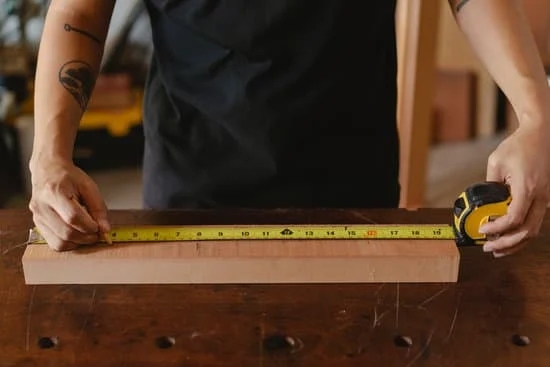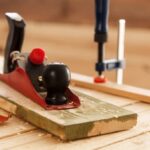Woodworkers rely on precision and accuracy when it comes to their craft, and having the right tools can make all the difference in their projects’ success. One essential tool for woodworkers is a moisture meter, which helps them ensure that the wood they are working with is at the optimal moisture content for their specific project.
By using a woodworkers moisture meter, professionals and hobbyists alike can avoid potential issues such as warping, cracking, or glue failure in their woodworking creations.
Monitoring moisture levels in wood is crucial because excess moisture can lead to a variety of problems during woodworking processes and after completion. Wood with high moisture content is prone to shrinking or expanding, which can ultimately ruin a project. A reliable moisture meter allows woodworkers to accurately measure the level of moisture in their wood materials to prevent these issues and produce high-quality results.
There are different types of moisture meters available for woodworkers, each designed to meet specific needs and preferences. From pin-type meters to pinless meters, these tools offer various features that cater to different woodworking projects and materials. Understanding the importance of selecting the right moisture meter for your needs is key in ensuring successful outcomes in your woodworking endeavors.
Importance of Monitoring Moisture Levels in Woodworking
Monitoring the moisture levels in wood is crucial for all woodworking projects. The woodworkers moisture meter plays a vital role in ensuring that the wood used is at the optimal moisture content for the project at hand. Wood that is too dry or too wet can lead to several issues that can affect the quality and longevity of the finished product.
Preventing Warping and Cracking
One of the main reasons why monitoring moisture levels is important in woodworking is to prevent warping and cracking of the wood. When wood absorbs or loses moisture, it expands or contracts accordingly. This can cause the wood to warp or crack, leading to structural issues in your project. By using a woodworkers moisture meter regularly, you can ensure that your wood remains at the ideal moisture content, preventing these problems from occurring.
Maintaining Adhesive Strength
Another key reason for monitoring moisture levels in woodworking is to maintain the strength of any adhesives used in the project. When wood has high moisture content, it can affect how well adhesives bond to the surface. This can result in joints coming apart or failing over time. By using a woodworkers moisture meter, you can ensure that your wood is at an optimal moisture level for adhesive bonding, leading to stronger and more durable woodworking projects.
Types of Moisture Meters for Woodworkers
Woodworkers rely heavily on the accuracy of their tools to ensure that their projects are successful and durable. One essential tool in a woodworker’s arsenal is a moisture meter specifically designed for woodworking purposes. These specialized meters allow woodworkers to accurately measure the moisture content of their wood, ensuring that it is at the optimal level for use in various projects.
When selecting a moisture meter for woodworking, there are several different types to choose from, each with its own set of features and benefits. Some of the most common types include pin-type meters, pinless meters, and combination meters. Pin-type meters use two metal pins that penetrate the surface of the wood to measure its moisture content.
Pinless meters, on the other hand, use electromagnetic signals to scan the wood without damaging its surface. Combination meters offer both pin-type and pinless capabilities for versatility in measuring different types of wood.
To help you make an informed decision when choosing a moisture meter for your woodworking needs, here are some key features to look out for:
1. Accuracy: Ensure that the meter provides accurate readings within a specific range.
2. Display: Look for a clear display that is easy to read and understand.
3. Calibration: Check if the meter can be calibrated regularly to maintain accuracy.
4. Measuring depth: Consider the depth at which the meter can measure moisture levels in wood.
5. Battery life: Opt for a meter with long-lasting battery life to avoid frequent replacements.
Investing in a high-quality moisture meter designed specifically for woodworking can greatly benefit your projects by ensuring that your wood is at the right moisture level before making any cuts or assembling pieces together. By choosing the right type of meter and learning how to properly use it, you can enhance your woodworking skills and create long-lasting, high-quality creations.
Features to Look for in a Quality Moisture Meter
Accuracy and Measurement Range
When choosing a moisture meter for woodworking projects, one of the most important features to consider is accuracy. A reliable moisture meter should provide precise measurements to ensure the wood is at the optimal moisture content for your project. Look for a meter with a wide measurement range to accommodate different types of wood species and moisture levels.
Pin or Pinless Design
Another key feature to look for in a quality moisture meter is the design – whether it uses pins or is pinless. Pin meters penetrate the wood surface to measure moisture content, while pinless meters use electromagnetic signals to detect moisture without damaging the wood. Consider your preferences and the type of woodworking projects you undertake when choosing between these two designs.
Data Storage and Calibration Options
For added convenience and versatility, opt for a moisture meter that offers data storage capabilities. This feature allows you to track and compare measurements over time, ensuring consistency in your woodworking projects. Additionally, look for a meter that can be easily calibrated to maintain accuracy over time, providing reliable results whenever you need to check the moisture content of your wood materials.
By considering these key features in a quality moisture meter, woodworkers can ensure they have the right tool to monitor and control the moisture levels in their wood materials effectively. Whether you are working on furniture, cabinets, or other woodworking projects, investing in a reliable moisture meter can help enhance the quality and longevity of your creations.
How to Properly Use a Moisture Meter for Woodworking Projects
Woodworkers often rely on moisture meters to ensure their wood is at the appropriate moisture levels for their projects. Using a moisture meter correctly is essential in order to obtain accurate readings and prevent issues such as warping, cracking, or mold growth in the wood. Here are some key steps on how to properly utilize a moisture meter for woodworking projects:
- Choose the right type of moisture meter: There are two main types of moisture meters used in woodworking – pin meters and pinless meters. Pin meters use metal pins to penetrate into the wood, while pinless meters work by scanning the surface of the wood. Consider the type of wood you are working with and your specific needs when selecting a moisture meter.
- Calibrate the meter: Before taking any measurements, it’s crucial to calibrate your moisture meter according to the manufacturer’s instructions. This ensures that you get accurate readings every time.
- Take multiple readings: To get a comprehensive understanding of the moisture content in your wood, take readings at different points and depths throughout the piece. This will help you identify any inconsistencies in moisture levels that may impact your project.
Properly using a woodworkers moisture meter can make a significant difference in the overall quality and longevity of your woodworking projects. By following these guidelines, you can ensure that your wood is at the optimal level of dryness for whatever project you are undertaking, whether it be furniture making, cabinetry, or any other woodworking endeavor.
Common Mistakes to Avoid When Using a Moisture Meter
When using a moisture meter for woodworking projects, there are several common mistakes that woodworkers should avoid to ensure the accuracy of their readings and prevent damage to their materials. One of the most common mistakes is not properly calibrating the moisture meter before taking measurements. Calibration is essential to ensure that the device provides accurate readings, so taking the time to calibrate it according to the manufacturer’s instructions is crucial.
Another mistake to avoid is not testing the moisture meter on a known dry surface before using it on wood. This step helps verify that the device is functioning correctly and gives a baseline reading for comparison. Additionally, using a moisture meter on wood that has been recently cut or planed can lead to misleading results due to surface moisture, so allowing sufficient time for acclimation is necessary for accurate readings.
It’s important for woodworkers to avoid relying solely on visual inspections when determining the moisture content of wood. While visual cues like cupping, warping, or cracking can indicate high moisture levels, they are not always reliable indicators. Using a moisture meter provides quantitative data that allows woodworkers to make informed decisions about when wood is ready for use in their projects.
| Mistake | Prevention |
|---|---|
| Not calibrating the moisture meter | Follow manufacturer’s instructions for calibration |
| Testing on unknown surfaces | Test on known dry surface first |
| Relying only on visual inspection | Use a moisture meter for accurate measurements |
By avoiding these common mistakes and following best practices for using a woodworker’s moisture meter, artisans can ensure that their woodworking projects are of high quality and built to last. Properly monitoring and managing moisture levels in wood not only improves project outcomes but also helps prevent potential issues such as mold growth or structural damage over time.
Investing in a quality moisture meter and developing good habits in its use will ultimately benefit both novice and experienced woodworkers alike.
Benefits of Using a Moisture Meter in Woodworking
Woodworkers understand the importance of ensuring that wood materials used in their projects have the right moisture content. This is where a woodworkers moisture meter comes into play. By utilizing this handy tool, woodworkers can accurately measure the moisture levels in different types of wood, allowing them to make informed decisions during the woodworking process.
One of the key benefits of using a moisture meter in woodworking is the ability to prevent issues such as warping, cracking, and mold growth in finished products. Excess moisture in wood can lead to these problems, which can compromise the quality and durability of the final piece. By regularly checking the moisture content with a moisture meter, woodworkers can ensure that their workpieces are properly dried and ready for use.
Another benefit of using a moisture meter is the cost-saving aspect it offers. Wood materials are an investment for any woodworking project, and improper drying or storage can result in wasted resources if the wood becomes damaged. By monitoring and maintaining the correct moisture levels with a moisture meter, woodworkers can extend the lifespan of their materials and reduce unnecessary expenses.
| Benefits | Explanation |
|---|---|
| Preventing issues like warping and cracking | By accurate measurement with a woodworkers moisture meter, these problems can be avoided |
| Cost savings | Maintaining correct moisture levels prolongs material lifespan and reduces unnecessary expenses |
Top Recommended Moisture Meters for Woodworkers
When it comes to woodworking, ensuring that the moisture levels in the wood are at an optimal range is crucial for the success of your projects. Investing in a high-quality moisture meter designed specifically for woodworkers is essential. A woodworkers moisture meter is a specialized tool that allows you to accurately measure the moisture content of wood before using it in your projects.
There are several top recommended moisture meters on the market that cater specifically to the needs of woodworkers. These meters are equipped with features that make them ideal for use in woodworking projects. One important feature to look for in a quality moisture meter is its accuracy and precision. Having a reliable and accurate measurement can make a significant difference in the outcome of your woodworking project.
Another important feature to consider when choosing a moisture meter for woodworking is its versatility. Look for a meter that can measure moisture levels in various types of wood, including hardwoods and softwoods. Some models also come with additional features such as temperature compensation and data logging capabilities, which can be useful for more advanced woodworking projects.
Overall, investing in a top recommended woodworkers moisture meter can greatly enhance the quality and longevity of your woodworking projects. By accurately monitoring and controlling the moisture levels in the wood you work with, you can prevent issues such as warping, cracking, or mold growth. With the right moisture meter by your side, you can ensure that your woodworking creations stand the test of time.
Conclusion
In conclusion, a reliable moisture meter is an indispensable tool for woodworkers looking to enhance their woodworking projects. By accurately monitoring moisture levels in wood, a woodworker can ensure the quality and longevity of their creations. Investing in a quality moisture meter allows for precise measurements that can prevent issues such as warping, cracking, and mold growth in finished pieces.
When choosing a moisture meter, it is important to consider important features such as accuracy, range, and ease of use. A good moisture meter should provide consistent and reliable readings across various types of wood. Additionally, understanding how to properly use a moisture meter is essential for accurate results – ensuring that the woodworker can make informed decisions throughout the woodworking process.
Overall, incorporating a moisture meter into your woodworking toolkit not only improves the quality of your projects but also saves time and resources by preventing potential issues caused by excess moisture in wood. With the wide range of moisture meters available on the market, woodworkers can choose the one that best suits their needs and budget to take their craft to the next level.
Remember that by investing in a reliable moisture meter, you are investing in the success and longevity of your woodworking projects.
Frequently Asked Questions
Do I Need a Moisture Meter for Woodworking?
A moisture meter is a valuable tool for woodworking, especially when working with wood that needs to be dry for specific projects. By measuring the moisture content of the wood, you can prevent issues like warping, cracking, or glue failure. It helps ensure that the wood is suitable for your intended use.
What Is a Good Moisture Level for Woodworking?
The ideal moisture level for woodworking depends on the type of wood and the climate in which you are working. Generally, a moisture content between 6-8% is considered optimal for indoor woodworking projects. However, if you are working outdoors or in more humid conditions, a slightly higher moisture content may be acceptable to prevent excessive drying and potential cracking.
What Is the Most Accurate Moisture Meter for Wood?
When looking for the most accurate moisture meter for wood, it’s important to consider factors like accuracy, reliability, and ease of use. Some popular options include pin-type meters and pinless meters, each with its own advantages depending on your specific needs.
Brands like Wagner Meters or Delmhorst are known for producing high-quality and accurate moisture meters for woodworking applications. Ultimately, the most accurate meter will depend on your budget and how often you plan to use it in your woodworking projects.

Hi everyone! I’m a woodworker and blogger, and this is my woodworking blog. In my blog, I share tips and tricks for woodworkers of all skill levels, as well as project ideas that you can try yourself.





